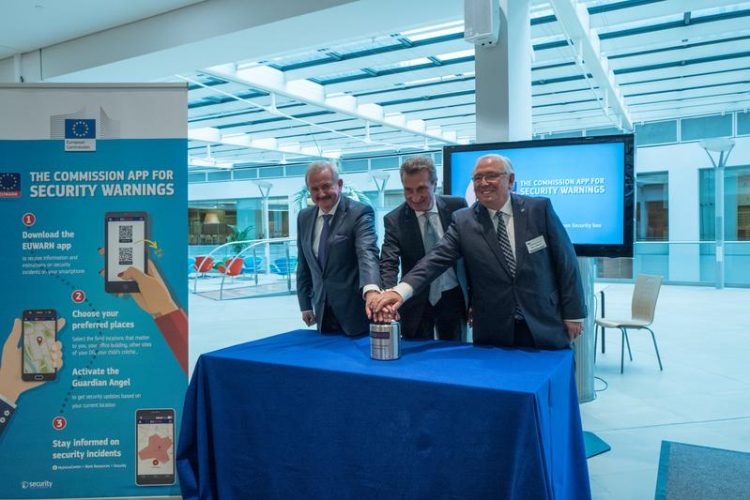Important step towards European warning system: European Commission launches warning app

At the official launch of »EUWARN« (from left to right): Prof. Reimund Neugebauer, President of the Fraunhofer-Gesellschaft, EU Commissioner Günther Oettinger and Ortwin Neuschwander, Managing Director of TURM solutions GmbH. Foto: European Commission
EU Commission staff will soon be receiving location-based danger alerts on their mobile phones from an app that calls their attention to potential hazards such as a building fire, a suspicious package or the threat of an attack.
Called EUWARN, this new warning system was launched in Brussels on September 11 by EU Commissioner Günther Oettinger, Fraunhofer President Prof. Dr. Reimund Neugebauer and TURM solutions GmbH CEO Ortwin Neuschwander.
Developed by the Fraunhofer Institute for Open Communication Systems FOKUS at the behest of TURM solutions, EUWARN is based on KATWARN, a public warning system deployed successfully in Germany and Austria for years now.
“The safety of our staff and visitors is my top priority. The terrorist attacks in Brussels are but one incident that showed us how vulnerable we are. The EUWARN app is a new internal warning system that enables us to reach our employees in Brussels and Luxembourg, with other locations to follow. It is designed so as to allow other EU institutions to use it in the future,” says Oettinger.
The EU Commission’s Security Directorate drafts these warning messages in German, English and French. Unlike the alerts issued via public warning apps, these warnings pertain exclusively to EU Commission venues and will, for the time being, address just EC employees.
The system is later to be connected to the public warning system KATWARN, which features a free app now available or slated for rollout in various European countries. “All visitors to EU Commission premises will then receive alerts and notifications via the KATWARN system,” says TURM solutions CEO Neuschwander.
From Fraunhofer President Prof. Neugebauer’s vantage point, EUWARN is both a success story and a calling. He believes all research in sunrise industries – security/safety, mobility, energy and environmental protection – has to be persistently European-minded. This is why talks about connecting the Fraunhofer European warning system to many other countries are already underway.
According to Neugebauer, “The fact that EUWARN is to launch on a day as rife with symbolism as September 11 is an admonishment for us to pull together to form an even more united international front on security issues. Fraunhofer stands firm beside the EU Commission and the entire European Union as a research partner.” The contracting parties TURM solutions and the EU Commission also see themselves as partners in service of public security in the EU.
The KATWARN system has been available to German security authorities as an SMS since 2011, and since 2012 as a more advanced service delivered via smartphone app. What sets KATWARN technology apart is the precision of its location-based service. It delivers alerts only to affected areas or buildings.
Launched in 2017, the KATWARN/Austria warning system is connected to the German KATWARN system. Fraunhofer will continue to upgrade the KATWARN system on behalf of TURM solutions, for example, to disseminate alerts via public ad screens, transportation services’ digital signage and passenger cars’ on-board computers, and adapt these warnings to the new 5G mobile radio standard. TURM solutions GmbH markets KATWARN across Europe and beyond.
Press Contacts:
Fraunhofer-Gesellschaft, Munich
Communications
Janis Eitner
Tel.: +49 (0)89 1205-1333
presse@zv.fraunhofer.de
Fraunhofer Institute for Open Communications Systems FOKUS, Berlin
Ulf Hoffmann
Director Corporate Communications
Tel: +49 (0)30 34 63-7242
ulf.hoffmann@fokus.fraunhofer.de
https://owncloud.fokus.fraunhofer.de/index.php/s/n9Nimi62eyW6faW Caption: At the official launch of »EUWARN« (from left to right): Prof. Reimund Neugebauer, President of the Fraunhofer-Gesellschaft, EU Commissioner Günther Oettinger and Ortwin Neuschwander, Managing Director of TURM solutions GmbH.
Media Contact
All latest news from the category: Information Technology
Here you can find a summary of innovations in the fields of information and data processing and up-to-date developments on IT equipment and hardware.
This area covers topics such as IT services, IT architectures, IT management and telecommunications.
Newest articles

High-energy-density aqueous battery based on halogen multi-electron transfer
Traditional non-aqueous lithium-ion batteries have a high energy density, but their safety is compromised due to the flammable organic electrolytes they utilize. Aqueous batteries use water as the solvent for…

First-ever combined heart pump and pig kidney transplant
…gives new hope to patient with terminal illness. Surgeons at NYU Langone Health performed the first-ever combined mechanical heart pump and gene-edited pig kidney transplant surgery in a 54-year-old woman…

Biophysics: Testing how well biomarkers work
LMU researchers have developed a method to determine how reliably target proteins can be labeled using super-resolution fluorescence microscopy. Modern microscopy techniques make it possible to examine the inner workings…





















